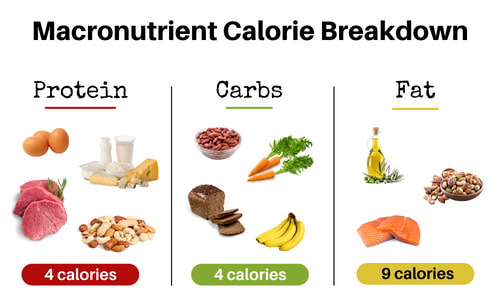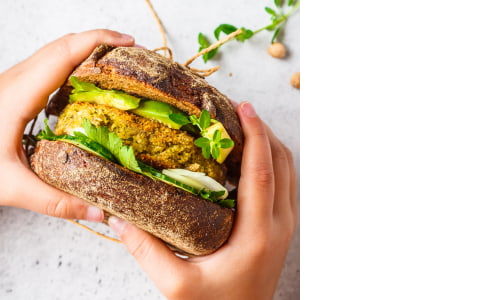“Easy High Calorie Meal Prep, According to an RD” was written by Grace Guthrie, MS, RD & edited/reviewed by Aly Bouzek, MS, RDN.
If you’re looking into meal prep, then you might also be looking to simplify your meals throughout the week. Meal prep is a wonderful way to take the stress out of figuring out what you’re going to eat at the last minute.
Meal prep can seem intimidating at first, and if you want to increase your calorie intake, it may feel like an additional challenge. Well, dietitians are a great resource for both of these topics, and we are happy to help!
In this article, we will go over some basics on calories and which foods are the most calorie-dense, then we’ll go over how to be a meal prep pro! Let’s get started!
How many calories do I need?
Calories are the building blocks of all the food we eat, but the question of how many calories we need per day is hard to answer. There are about as many answers to this question as there are people asking it!
As a general rule of thumb, the average person needs about 25–30 calories per kilogram of body weight every day to maintain their current weight.
To find that number for yourself, take your body weight and divide it by 2.2. This will convert your weight from pounds (lbs) to kilograms (kgs). Next, multiply your weight in kilograms by 25 to get the low end of your calorie range. Then, multiply your weight in kilograms by 30 to get the upper end of your calorie range.
In practice, for someone who weighs 165 pounds, it looks like this:
165 lbs / 2.2 = 75 kgs
75 kgs x 25 = 1875 calories
75 kgs x 30 = 2250 calories
So for a 165 pound person, a calorie range of 1875–2250 calories per day would likely be enough calories. However, a big caveat here is that this rule of thumb doesn’t take into account a lot of factors, such as:
- physical activity
- age
- pregnancy status
- malnutrition
- injuries
While you can use this rule of thumb to calculate an estimated calorie range, for the most accurate information, we recommend you consult with your doctor or a registered dietitian.
Who might need high calorie meals?
Now that we have a general calorie range established, there are some people who will need even more calories. This could be due to a wide variety of reasons, but here are a few.
Chronic Conditions
Certain chronic conditions raise our basal metabolic rate (BMR), which means we burn more calories at rest. What this means nutritionally is that these people need to eat more calories every day to avoid weight loss.
A few chronic conditions that are known to increase BMR are COPD, kidney disease, and cystic fibrosis. (1,2)
Injury/illness Recovery
Anyone who has sustained an injury knows that it can take a while to get back to your usual activity level. A big part of that is that your body is rebuilding and repairing the site of your injury, which takes time, rest, and extra calories.
The same is true for illness. When we are sick, we burn more calories because our body is working harder to keep everything working. In both the care of injury and illness, it’s important to increase your calorie intake to promote healing and prevent weight loss.
Anyone Wanting to Gain Weight
Last, a lot of our readers here on The Geriatric Dietitian come to us for tips on gaining weight. Anyone who has experienced some unintended weight loss, is trying to preserve muscle mass as they age, or even athletes might need to increase their calorie intake to gain weight.
Calorie-dense Foods
Now that we’ve established who might want to gain weight, let’s talk about the types of foods to focus on eating when trying to gain weight.
All the food we eat is made up of 3 macronutrients: protein, carbohydrates, and fat. All the macronutrients play a vital role in satisfaction, flavor, and muscle mass development. It’s a good idea to include some of all 3 macronutrients in all of your meals.
That being said, carbohydrates and protein provide 4 calories per gram, while fat provides 9 calories per gram. What this means is that you’ll get more calories in the same volume of fat compared to protein or carbohydrates.
We want to keep this in mind when building our high calorie meal prep, since fat is a great way to add a calorie boost without adding too much volume!

What is meal prep?
Meal prep has been trending for a few years now, and you might see it described differently in different places. For this article, we’re talking about preparing meals ahead of time so that you don’t have to stress about what you’re going to eat at the last minute!
Oftentimes people use meal prep for breakfast and lunch since many people eat those meals at work or on-the-go. But meal prep doesn’t have to be limited to those meals! Meal prepping dinner can be a great way to reduce cooking time after work and get food on the table faster.
Components of a high calorie meal prep
When coming up with the components of a meal prep, let’s remember our 3 macronutrients. At each meal we want to have a protein source, a carbohydrate source, and a fat source. Let’s look at some options for each.
Protein
Protein is the macronutrient most involved in muscle growth and preservation, so we always want to have a protein source on our plate. Meat is a classic protein source, however eggs, beans, legumes, and soy products are also great options to keep in mind.
Here are some ideas for protein sources that can be prepped at the beginning of the week and used in a variety of dishes:
Carbohydrate
Next up are the carbs. Carbs are our body’s favorite fuel source because they’re easy to break down. Also, did you know eating a carb-rich meal can actually cause levels of serotonin, one of our feel-good hormones, to rise? Carbs are a great base for meals and can be prepped ahead of time!
Here are some ideas for carbohydrates that you can prepare early or just keep on hand.
- Seasoned Quinoa
- Rice Pilaf
- Tortillas and wraps
- Sandwich bread
- Roasted Potatoes
Fruit and vegetables also count as carbs and can be a great addition to a meal prep. Items like sliced carrots, bell peppers, or cucumbers can be prepped one day and used throughout the week for an easy side. Plus, the dressings in the next section can be used as dipping sauces!
Fat
The last component we want to include is some kind of fat. As we talked about earlier, fat is more calorie-dense than carbs and protein, so it’s a great way to top a meal with extra calories.
Besides being calorie-dense, fat is also a great way to add flavor to your meals. A lot of the protein and carb options we’ve talked about actually have some fat in them already! Ingredients like olive oil, butter, mayo, and cheese are all considered fat sources.
One of our favorite ways to add fat to meals is as a dressing or a topping. Here are some great options to try.
- Sliced avocado
- Crumbled feta or goat cheese
- Green Goddess Dressing
- Greek Yogurt Ranch Dip
- Pumpkin or sunflower seeds
- Walnuts, pistachios, pecans
Putting together your high calorie meal prep
Now that we’ve got all of our ingredients prepped, putting it together takes almost no time at all! This can all be done at the start of the week, or you can do it the day of. Here are a couple ideas for how you could mix and match these ingredients:
NOTE: If you’re using a store-bought product, always use the nutrition information listed on the label as your guide!
Chicken Salad Wrap
- 1 sun dried tomato wrap (220 calories) + 1 serving chicken salad (200 calories) + ¼ cup chopped walnuts (200 calories)
- Side of 1 cup carrot sticks (50 calories) + 1 serving Greek Yogurt Ranch Dip (130 calories)
- Calorie total: 800
Grilled Chicken Bowl
- ¾ cup grilled chicken (200 calories) + 1 serving seasoned quinoa (300 calories) + 2 tbsp Green Goddess Dressing (120 calories) + ¼ cup pumpkin seeds (180 calories)
- Calorie total: 800
Chickpea Fritters Sandwich
- 2 slices whole wheat bread (240 calories) + 3 chickpea fritters (230 calories) + ½ avocado sliced or mashed (160 calories) + 2 tbsp Green Goddess Dressing (120 calories)
- Calorie total: 750
While these are just a few ideas, hopefully you see how prepping a few protein, carb, and fat choices can make it easy to create easy meals that help you meet your calorie goals!

Easy High Calorie Meal Prep Conclusion
Meal prep is a great tool to make your life easier and still make sure you get in the right amount of calories each day. One of the best ways to meal prep that prevents boredom is to prep a couple items that are all be used interchangeably throughout the week.
When building your high calorie meal prep, just make sure that you always have at least one protein, carb, or fat in your meal. You could definitely use two fats if you’re feeling extra hungry! Let us know in the comments which meals you try, and feel free to share one of your favorite meal prep recipes!
Looking for even more info on easy meal prep? Don’t miss our articles:
